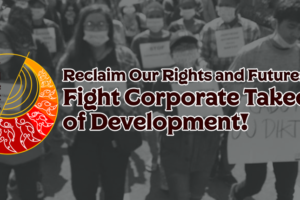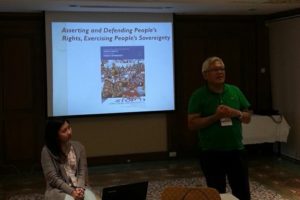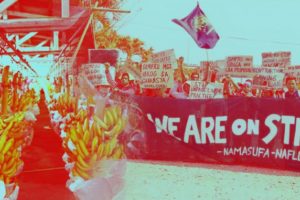Photos: commons.wikimedia.org, kremlin.ru
On 27 November 2019, IBON International spoke at a conference about Southern debt and the question of China, organised in Germany by erlassjahr.de and other civil society organisations. The following article is derived and expanded from the positions shared by the organisation at the conference.
China today has been figuring more in conversations about debt. The rising power has its Belt and Road Initiative (BRI), to which accusations of “debt-trap diplomacy” are attached by some of the United States’ (US) policy-makers, among others.
The BRI, and the increasing concerns on China, cannot be separated from the growing power struggles in Asia. The BRI comprises of economic corridors where infrastructure, but also increasing trade, financial and policy links, are to be established. It extends to Europe, even a part of Africa, but most especially across Asia. It arose as an effort to export China’s excess capital and production capacity.
But it can also be seen as a response to the “US pivot” to Asia after 2008, and now, the declining hegemon’s “Indo-Pacific Strategy.” In 2018, there was even a counter-response from the US, Australia, Japan: a “trilateral partnership” in development finance responding to “state-directed initiatives that can leave developing countries worse off,”[i] a possible nod to US views on the BRI.
The BRI, and the increasing concerns on China, cannot be separated from the growing power struggles in Asia.
Asian debt today
How well-founded are accusations that the BRI and China’s lending are a trap for Southern peoples, such as in Asia? Looking at the Asian debt situation shows that past and present debt burdens from traditional creditors remain.
Debt in Asia has been rising since the 1970s.This applies to total debt stocks, sovereign debt (“public and publicly-guaranteed debt”) and private debt. From available World Bank data, it can be concluded that sovereign debt in Asia today is largely interest-bearing capital payable to, in the following order: 1) private lenders (banks, institutional investors such as investment funds, individual bondholders); 2) multilateral lenders (e.g., IMF-WB, ADB); and 3) bilateral lenders.[ii]
Systemic indebtedness hounds Southern countries
It is essential to stress that over-indebtedness in Asia, as in other Southern regions, is attributable to systemic factors arising from dominant economic paradigms and from the important roles played by international finance institutions such as the International Monetary Fund (IMF) in this world economy. In Latin America, the protests in Chile and Ecuador, in defence of people’s economic rights against capital-friendly neoliberal policies, are a symptom of this structural problem.
From the side of big business and their home states, capital needs to circulate and accumulate. This is through cross-border investment with significant returns, or debt with interest. After the 2008 crisis, the US lowered its interest rates which drove lenders to seek higher returns to interest-bearing capital abroad, such as in countries of the global South. China has been a long-time debtor especially after market reforms, before the rise in its lending especially in the 21st century. According to some, China’s lending today has been grossly underestimated, due to its reporting gaps to institutions that monitor lending flows, such as the World Bank.
Over-indebtedness in the global South is attributable to systemic factors arising from dominant economic paradigms.
From the debtor side, remaining structural legacies of a world economy captured by big corporations and international institutions (commonly backed by the US and its allies) have been troubling people’s economic rights in the South. Southern elites’ linkages with lenders and investors’ capital-holding groups, institutions and thus, foreign economic policy, have been tighter. Domestic productive capacities have been hollowed out as they were “integrated” to “global markets” (e.g., making them low-waged labour sources for export goods of corporations that capture “global value chains”).
Southern countries have been driven to increasing reliance on the unequal playing fields of foreign markets, including external sources of financing—such as debt—for economic activity. This re-orientation has been driving a “need” to constantly borrow (and “attract” foreign investment). China is a rising actor in this systemic indebtedness, and adds to the debt legacies of traditional lenders, and not “anti-imperialist solidarity” and a misleading “cooperation” between Southern states.
Structural issues: Mongolia, Pakistan, Philippines
Historical dependence on a few kinds of export commodities has been a crucial factor for Mongolia. Exports provide earnings of foreign currency, used by governments to service foreign debts usually contracted in dollars. But low commodity prices after 2011, for the mineral export-reliant Mongolian economy, made it difficult to pay foreign debts. A resulting IMF program recommended continuing mineral exports despite this systemic issue.
Pakistan is another country with debt issues, trapped in a cycle of debt, IMF structural adjustment, and more debt. Despite twelve “bail out” loans from the IMF (and therefore at least twelve sets of structural adjustment “reforms”) since the mid-20th century, the government still found itself driven to have another IMF emergency loan for debt problems in 2018. The IMF and the government eventually prioritised paying debts to China, while passing the burden of increasing taxes to the people.
In the Philippines, a historically hollowed-out industry and agricultural sector from years of prioritising foreign extraction and unequal agreements have driven today’s loan drive for infrastructure priorities. While the government has been making it a point to appropriate budget to pay creditors, recent links with sources of foreign capital continue to have adverse effects on the ground. The Kaliwa Dam and the Chico River Pump Irrigation Project, both funded by China’s lending, have been controversial for entailing dangerous loan agreements. On the other hand, the Asian Development Bank (ADB) has signed a USD 2.57 billion loan to co-finance a railway connecting Manila to the New Clark City (NCC), a “sustainable city” project under construction.[iii] The loan-backed railway plan is targeted for 2025 but the 9,450-hectare NCC has proceeded without people’s consent and already displaced indigenous and farm communities and destroyed agricultural livelihoods. Such projects tolerate such impacts in the name of connectivity and false sustainability.[iv]
Ways forward: Beyond the US and China
Given the political interests of old and rising powers, civil society and people’s organisations in the region must have the option to choose neither US nor China, as they must have the right to determine their own development paths.
Realising people’s sovereignty, including the substantive influence of the grassroots in development planning and other processes, requires a redistribution of political power. This would open up policy options for Southern peoples. They can work to increase the dynamism of domestic economies to reverse dependence on external financing and towards a level of self-sufficiency.
Civil society and people’s organisations must have the right to determine their own development paths.
Southern countries could then hold country-level and people-led assessments of the impacts of creditors’ lending and structural adjustment reforms. Larger shifts such as strategic industrial policy would also be essential, as well as an agrarian reform based on a “land to the tillers” principle and food sovereignty. Other policy options that would open up vis-à-vis the current norm of deregulation, such as controls on external borrowing and foreign direct investment (FDI); and re-examinations of current Southern government debts for possible cancellations. Revenue and spending could be reformed: with budget re-allocations for social service spending and away from debt servicing; repealing taxes that burden the poor and a corresponding progressive taxation of elites and multinational enterprises; and halting “transfer-pricing” and other illicit flows.
External conditions to such a new internal dynamic are also needed. There must be shifts in the financial system and away from the current economic paradigm. Part of this economic paradigm is the blanket promotion in the South of a reliance on external finance and capital as drivers of Southern economies: which includes external debt, but also unstable global finance markets, to FDI and TNC-led production networks (“global value chains”). Given the character of the international economic system, many of these external capital sources remain captured by, and work to generate higher returns for, monopoly capitalist corporations and the states in which they are headquartered.
People’s assertions exist amid the state of debt and the roles of big foreign capital. In Pakistan, small shopkeepers have launched a “strike” and closed their stores to protest the new taxes imposed to generate revenue. However, resistance to China’s investments and loans remains to be seen. In the Philippines, there is indigenous resistance to ADB-backed development aggression, in the case of the so-called “sustainable city” project, the New Clark City. Indigenous peoples in the Northern regions of the country also oppose two dams backed by China’s loans, projects which violate the right to self-determination in the worst country for environmental defenders. Such resistance and people’s assertions of their rights and sovereignty must be strengthened. #
__________________________
[i] Overseas Private Investment Corporation. 2018. “US-Japan-Australia sign first trilateral agreement on development finance collaboration.” https://www.opic.gov/press-releases/2018/us-japan-australia-sign-first-trilateral-agreement-development-finance-collaboration
[ii] IBON International. 2019. “Old shackles, rising new masters? On Southern debt today.” https://iboninternational.org/download/old-shackles-rising-new-masters-on-southern-debt-today/
[iv] IBON International. 2019. “The New Clark City, a government sell-out of IP and peasant land for private interests.” https://iboninternational.org/2019/12/13/the-new-clark-city-a-government-sell-out-of-ip-and-peasant-land-for-private-interests/



